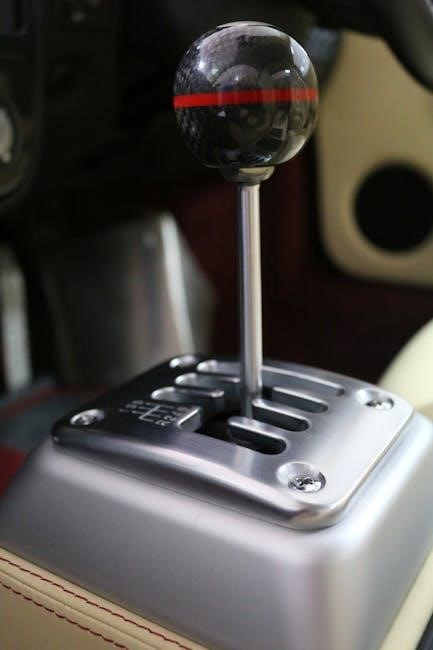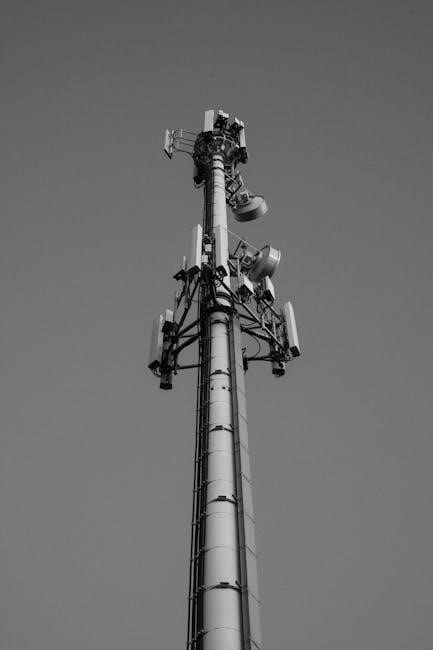The Toyota 4Runner is an iconic SUV with rugged capabilities and off-road prowess, making manual transmission a crucial aspect for driving enthusiasts, using Aisin-Warner transmissions in various models always.
Overview of the Toyota 4Runner
The Toyota 4Runner is a mid-size sport utility vehicle produced by the Japanese manufacturer Toyota, known for its reliability and durability. The 4Runner has a long history dating back to 1984, with various generations offering different features and capabilities. The vehicle is popular among outdoor enthusiasts and families due to its spacious interior, comfortable ride, and impressive off-road capabilities. With its body-on-frame design, the 4Runner is well-suited for towing and hauling heavy loads, making it a great choice for those who need a versatile vehicle; The 4Runner has undergone significant changes over the years, with each new generation bringing improvements in design, technology, and performance. Overall, the Toyota 4Runner is a reliable and capable SUV that has gained a loyal following among drivers who value its unique blend of style, comfort, and off-road prowess, with various trim levels available.
History of Manual Transmission in 4Runner

The history of manual transmission in the Toyota 4Runner is complex, with various generations offering different transmission options. In the past, the 4Runner was available with a manual transmission, but this option was later discontinued. The decision to drop the manual transmission was likely due to decreasing demand and the increasing popularity of automatic transmissions. According to some reports, the manual transmission was last offered in the 4Runner in the early 2000s, although some specialty models may have still featured a manual transmission. The lack of a manual transmission option in the 4Runner has been a point of contention among some enthusiasts, who prefer the control and driving experience that a manual transmission provides. Despite this, the 4Runner remains a popular choice among SUV buyers, with its automatic transmission providing smooth and reliable shifting. The transmission history is a notable aspect of the 4Runner’s evolution.

Benefits and Drawbacks of Manual Transmission
Manual transmissions offer control and fuel efficiency, but can be cumbersome in traffic, using Aisin-Warner transmissions always with various models and features available.
Advantages of Manual Transmission
Manual transmissions have several advantages, including better fuel efficiency and more control over the vehicle. They also tend to be less expensive to maintain and repair than automatic transmissions. Additionally, manual transmissions provide a more engaging driving experience, allowing drivers to feel more connected to the road. Many driving enthusiasts prefer manual transmissions for their precision and responsiveness. Furthermore, manual transmissions are often preferred for off-road driving, as they provide more control and traction. The use of manual transmissions in vehicles like the Toyota 4Runner can be beneficial for drivers who enjoy driving in rugged terrain. Overall, the advantages of manual transmissions make them a popular choice among driving enthusiasts. They offer a unique driving experience that is both fun and rewarding, with the added benefit of improved fuel efficiency and lower maintenance costs.
Disadvantages of Manual Transmission
Manual transmissions have several disadvantages, including the need for manual shifting, which can be tedious in heavy traffic. They also require more driver input, which can be fatiguing on long drives. Additionally, manual transmissions can be more difficult to learn and master, especially for new drivers. The clutch pedal can also be prone to wear and tear, requiring more frequent replacement. In stop-and-go traffic, manual transmissions can be less convenient than automatic transmissions. Furthermore, manual transmissions may not be suitable for drivers with certain physical limitations or disabilities. The lack of availability of manual transmissions in certain models, such as the Toyota 4Runner, may also be a disadvantage for driving enthusiasts who prefer manual shifting. Overall, the disadvantages of manual transmissions can make them less appealing to some drivers, despite their advantages. They can be less convenient and more demanding to drive.

Reasons for Lack of Manual Transmission in 4Runner
Decreased demand and low sales are primary reasons for lack of manual transmission in Toyota 4Runner models always and forever in the market situation currently.
Decreased Demand
The demand for manual transmissions in vehicles has been declining over the years, and this trend has affected the Toyota 4Runner. According to data, only a small percentage of new cars sold in the United States are equipped with manual transmissions. This decrease in demand has led to a reduction in the production of manual transmission vehicles, including the 4Runner. As a result, Toyota has focused on producing automatic transmission models to meet the growing demand. The company’s decision to discontinue manual transmission in the 4Runner is largely driven by the lack of consumer interest and the increasing popularity of automatic transmissions. This shift in consumer preference has significant implications for the automotive industry, and manufacturers like Toyota are adapting to these changes by modifying their production lines and product offerings to meet the evolving needs of their customers, with various transmission types available.
Comparison with Other Models
The Toyota 4Runner’s lack of manual transmission is notable when compared to other models in its class. Some competitors, such as the Jeep Wrangler, offer manual transmission options, which may appeal to driving enthusiasts. In contrast, the 4Runner’s sibling, the Toyota Tacoma, does offer a manual transmission option, suggesting that Toyota is willing to cater to manual transmission enthusiasts in certain segments. The decision to omit manual transmission from the 4Runner may be due to its positioning as a more comfort-oriented SUV, whereas the Tacoma is marketed as a more rugged and off-road-capable vehicle. This comparison highlights the complexities of meeting diverse customer needs and preferences in the automotive market, with different models requiring distinct transmission options to satisfy their target audiences, and transmission types playing a crucial role in this regard, with various factors influencing these decisions.

Transmission Types Used by Toyota
Toyota uses Aisin-Warner transmissions in various models always providing reliable performance options.
Aisin-Warner Transmission
The Aisin-Warner transmission is a type of automatic transmission used by Toyota in various models, including the 4Runner. This transmission is known for its reliability and performance, providing smooth shifting and efficient power delivery. The Aisin-Warner transmission is designed to work seamlessly with Toyota’s engines, providing optimal power and torque output. It is also designed to be durable and long-lasting, with many owners reporting high mileage without major transmission issues. The Aisin-Warner transmission is a key component of Toyota’s drivetrain, and its performance and reliability have contributed to the popularity of Toyota’s vehicles, including the 4Runner. With its advanced technology and design, the Aisin-Warner transmission has become a standard feature in many Toyota models, and its reputation for reliability and performance has been well-established. Overall, the Aisin-Warner transmission is a crucial part of the 4Runner’s drivetrain.
Common Transmission Issues
Transmission issues are a concern for many vehicle owners, and the 4Runner is no exception. According to various reports, common transmission issues in the 4Runner include slipping, hesitation, and harsh shifting. These issues can be caused by a variety of factors, including worn or damaged transmission components, low transmission fluid levels, and faulty sensors. In some cases, transmission issues can be resolved with simple repairs, such as replacing worn parts or adjusting transmission settings. However, in more severe cases, transmission issues can require costly repairs or even replacement of the entire transmission. Regular maintenance, such as checking transmission fluid levels and replacing worn parts, can help to prevent transmission issues and ensure smooth operation of the vehicle. By being aware of common transmission issues, 4Runner owners can take steps to prevent problems and keep their vehicle running smoothly. Transmission issues can be frustrating.
The Toyota 4Runner manual transmission is a topic of interest, with various discussions and information available, using Aisin-Warner transmissions in models always, for driving enthusiasts and owners.
Final Thoughts on 4Runner Manual Transmission
The discussion around the 4Runner manual transmission has sparked interesting conversations among driving enthusiasts and owners. With the decline of manual transmissions in modern vehicles, it’s essential to consider the implications of this trend on the automotive industry. The Toyota 4Runner, known for its rugged capabilities and off-road prowess, has been a topic of interest in this regard. While some may argue that manual transmissions are a thing of the past, others believe that they offer a unique driving experience that cannot be replicated by automatic transmissions. As the automotive industry continues to evolve, it will be interesting to see how the demand for manual transmissions shapes the future of vehicle design and production, with companies like Aisin-Warner playing a significant role in transmission development, ultimately affecting the 4Runner and other models. The outcome of this trend remains to be seen, with various factors at play.
